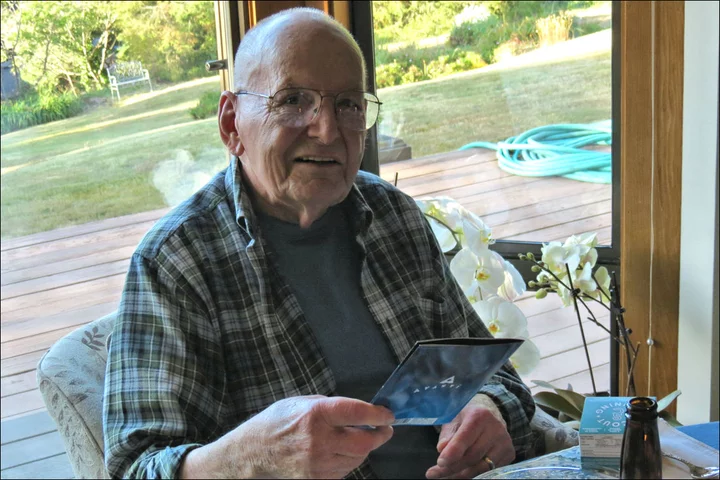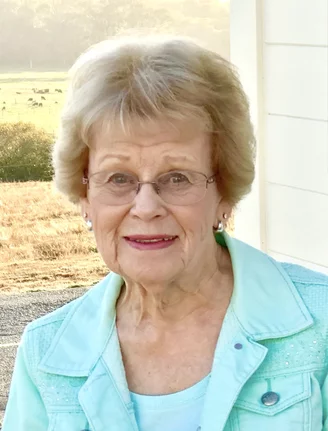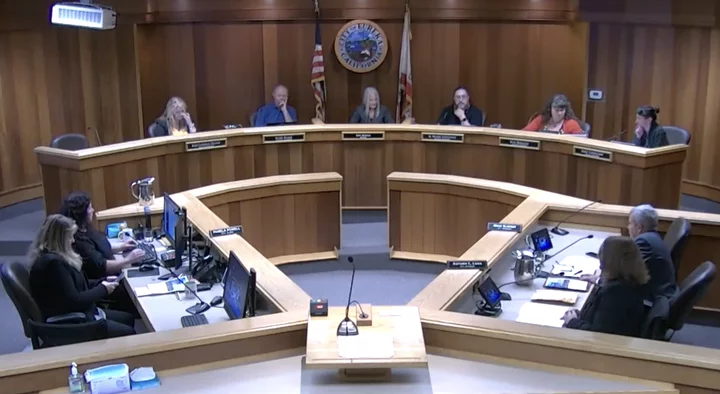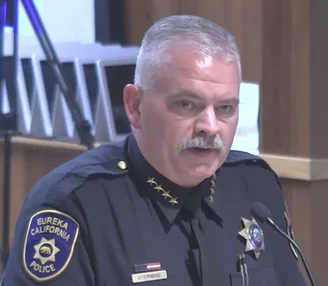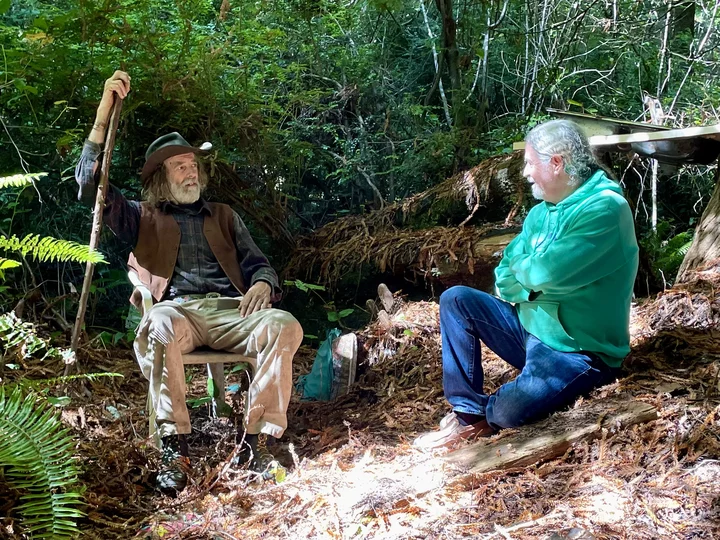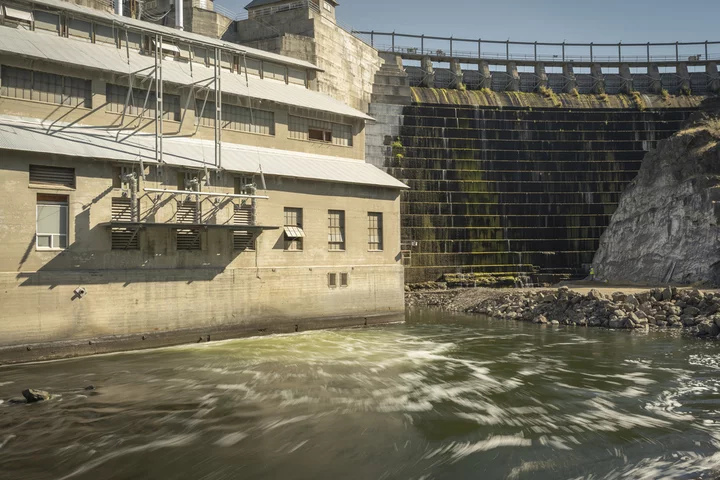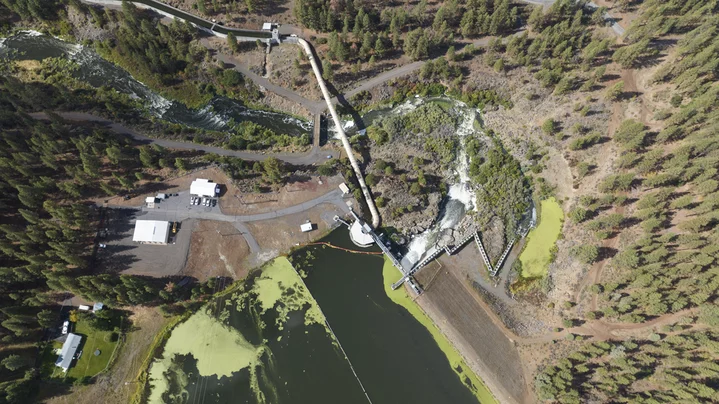OBITUARY: Preston Lea ‘Pete’ Spruance Jr., 1933-2024
LoCO Staff / Thursday, Oct. 3, 2024 @ 6:56 a.m. / Obits
Preston Lea “Pete”
Spruance Jr. died on July 23, 2024 in Eureka. He had
celebrated his 91st birthday just nine days earlier and
said he was quite elated to have made it that far.
Pete was born July 14, 1933 in Norfolk, Virginia to Preston Lea Spruance and Margaret Halsey Spruance. He grew up in Wilmington, Delaware and attended Tower Hill School. He prepared at The Lawrenceville School where he graduated Cum Laude. While at Lawrenceville, he played football, contributed poems and essays to the quarterly literary publication winning a coveted essay prize, and played trombone in a Dixieland dance band.
Pete loved sailing and owned a few motor and sailboats, and he crewed on ocean racing boats during his early years on the East Coast. He spent a brief time at Princeton and MIT before settling on Ithaca College, where he had a double major in math and music, graduating Magna Cum Laude with Departmental Honors in Mathematics. Later, he earned a masters degree in Human Behavior at United States International University.
In the mid-1980s, he completed the course work at Humboldt State University for what he smilingly termed “another worthless masters degree.” When his papers were lost, he was asked to fill in teaching anthropology to incoming students, an experience he thoroughly enjoyed.
In 1960 the Navy brought him and other East Coast family members to Coronado, California for the 50th anniversary celebration of Naval Aviation and the dedication of Halsey Field at the North Island Naval Air Station to his grandfather, Fleet Admiral William Frederick Halsey, Jr. He raised the commissioning pennant on the newly commissioned USS Halsey DDG 97 in San Diego 45 years later.
In 1961 he left his actuarial department job at John Hancock, Boston, to accept a job offer at Scripps Institution of Oceanography in La Jolla, as statistician in charge of data processing for research projects. While living in San Diego, Pete would be known to single-hand his skipjack schooner to Catalina Island. In the mid-1960s he picked up the trombone again to play weekly in the Jewel City Jass Band to SRO crowds at a nightspot in La Jolla.
He met his future wife, Nancy, in 1964 in San Francisco while accompanying a couple of other West Coast Spruances who had gathered to pay a visit to Admiral Raymond Spruance, retired, living on the Monterey Peninsula. Pete and Nancy were married later that year in Sausalito and continued living in San Diego County. Their two sons, Bruce and Trey, were born in 1966 and 1969 respectively.
Pete’s work career in San Diego as systems analyst on tactical data systems and other areas of research continued at Univac and other defense contract-oriented corporations. When the defense contract market softened in the late 1960s, he became a broker in commercial real estate sales. In the late 1970s, Pete was invited to return to government contract work, and he relocated his family to Eureka to manage a contract at the naval facility Centerville Beach. He retired in 1984 when that contract ended.
He was an enthusiastic and passionate learner who had many interests. Once captured by a subject, he would get to work learning fundamentals before proceeding. As an amateur radio operator (KE6LF), he built his first radio, a Heathkit, and spent decades communicating with other hams, working at repeater sites and volunteering his services where needed as an Emergency Coordinator with OES, the Red Cross and at some very lively Kinetic Sculpture races in the early 1980s. An interest in birds bolstered by Cornell Lab’s correspondence course on birds opened many years of local fun and adventurous trips and a life list of over 1,000 world birds. During this time, he discovered small-ship expedition cruising, which took him to all seven continents and over 100 islands, inhabited and uninhabited, searching for endemics. When Zodiac rides became too challenging, he turned to Atlantic crossings on small ships and on three- and five-masted sailing ships for the sheer joy of being on the water.
Pete was a loving husband and father who anchored his family by allowing personal growth to blossom unhindered and encouraged and assisted his sons’ likes and passions as those grew and evolved. An example of this dedication would be his 26-year twilight career (from 1998 to 2024) handling the complex duties at the management helm of his son’s small record company, website and retail mail-order business.
Pete loved taking his family on camping trips throughout California and the West, listening to and discussing classical music, and was an avid reader on many subjects – the great number of books he had amassed on the age of sail and naval history before he crossed over the bar attests to his passionate range of life-interests.
Pete is survived by his wife of close to 60 years, Nancy; sons Halsey Brewster “Bruce” Spruance (Alisha); Preston Lea “Trey” Spruance, III (Fernanda); brother William Halsey Spruance (Gretchen); sister Alice Spruance Talbot (Richmond); and grandson Jacob Logan Spruance. He was predeceased by his parents and sister, Margaret Grandy Spruance Denham.
###
The obituary above was submitted on behalf of Pete Spruance’s loved ones. The Lost Coast Outpost runs obituaries of Humboldt County residents at no charge. See guidelines here. Email news@lostcoastoutpost.com.
BOOKED
Today: 7 felonies, 9 misdemeanors, 0 infractions
JUDGED
Humboldt County Superior Court Calendar: Yesterday
CHP REPORTS
Crawford Rd / Refuse Rd (HM office): Report of Fire
8200 MM101 N MEN 82.00 (HM office): Trfc Collision-No Inj
3223 Mm36 E Tri R32.20 (RD office): Trfc Collision-Major Inj
5600 Mm101 N Men 56.00 (HM office): Assist with Construction
ELSEWHERE
RHBB: Wildfire near Covelo could burn hundreds of acres, evacuations underway
NCJ: Fatal Shooting of Suspect in Blue Lake Under Investigation
RHBB: Safeway Stores to Remain Open as Union Reaches Tentative Deal with Company
CBS Sacramento: Safeway workers in Northern, Central California set new midnight strike deadline
OBITUARY: Carolyn Ann Moore Hunt, 1936-2024
LoCO Staff / Thursday, Oct. 3, 2024 @ 6:56 a.m. / Obits
Carolyn Ann Moore Hunt passed away after a brief illness on September
23, 2024, at Providence St. Joseph Hospital in Eureka.
In Carolyn’s own words:
I was Born on June 11, 1936, in Redwood City, California and was the first child of Jack Eugene Moore and Evelyn Sarah (Lightbody) Moore. I was of the sixth generation to live in California, as my Moore ancestors arrived in Santa Cruz in 1847. My family left Menlo Park after WWII to spend six years in Centralia, Washington, when dad lived his life-time dream of opening a furniture store. By 1952 we were again in Menlo Park for nine months before moving to Arcata.
On my first day of class I met my life-long friend Karen Krestensen. I graduated from Arcata Union High School in 1954, and then attended Humboldt State College, majoring in their secretarial program, which was the norm for ladies at that time.
I met Richard Hunt on a blind date, and we married on Nov 11, 1956. Rich was from a pioneer Humboldt County ranching family, and I learned without delay to keep the ranch records, prepare meals for the help and become a mother of three sons, Dean and Dana (Lucas) Brian and Cindi (Anderson) and Scott and Sandi (Stafford).
In addition to my ranch duties, I was active in the Humboldt County Cowbelles/Cattlewomen, Humboldt Sponsors, Pacific Union School PTA. As an active member of St. Alban’s Episcopal Church since the late 1950s, I cannot even estimate the number of meals and coffee hours and altar guild duties I performed. My focus was my sons, six grandchildren, Jason (Jenna), Cory (Andreena), Chris (Kristina), Kendall (Stephanie), Tyler, and Alex (Shelby) and 10 great-grandchildren, the ranch and friends.
After dad died in 1973, I took an active part in managing and owning an interest in Baker and Stanton Furniture until it closed in 1996.
I loved playing bridge and was active from the time my boys were young. At one time I belonged to three bridge clubs. Historically, I had dreadful hands, but was convinced that being with longtime friends was worth the frustrations. Fifty-two pieces of card stock was not going to separate me from my friends!
I am grateful I was able to raise my sons as a “stay-at-home” mom! I am grateful for having my family close by so I could be a part of their lives. In addition, two of my sons and their wives live within walking distance of my home, supporting me in so many wonderful ways. Writing in my journal through the tough times and my faith has helped me see that I have lived a wonderful life!
The saddest day of our lives was the day our middle son, Brian, passed away at the age of 51. His personal and professional reputation resulted in one of the largest services in Humboldt County.
I was preceded in death by my parents, my husband Rich, my son Brian, sister-in-law Peggy Stebbins and her husband Laurald and Rich’s parents Esma and Vinal Hunt.
The family would like to thank her loving in-home caregivers who made it possible for her to remain in her home. We would also like to acknowledge the outstanding care she received at Providence St. Joseph Hospital.
Services to be held on Saturday, November 16, 2024, at 11 a.m. at St. Alban’s Episcopal Church in Arcata followed by a celebration of life for Carolyn and Rich from 1 to 4 p.m. at the Ingomar Club in Eureka.
Consider donating to St. Alban’s Episcopal Church, Humboldt Sponsors, Humboldt County Cattlewomen or a charity of your choice.
###
The obituary above was submitted on behalf of Carolyn Hunt’s loved ones. The Lost Coast Outpost runs obituaries of Humboldt County residents at no charge. See guidelines here. Email news@lostcoastoutpost.com.
Eureka City Council Tables Decision on Police Surveillance Cameras, Citing Privacy Concerns
Isabella Vanderheiden / Wednesday, Oct. 2, 2024 @ 5:27 p.m. / Local Government
Screenshot of Tuesday’s Eureka Council meeting.
###
How far should the Eureka Police Department take crime surveillance in the city?
At Tuesday’s meeting, the Eureka City Council weighed the pros and cons of a proposal from the Eureka Police Department to install 21 automated license plate-reading (ALPR) cameras along the city’s main thoroughfares. After an extensive conversation, the council ultimately voted to table its decision due to privacy concerns.
The technology, which would be provided by Flock Safety, collects license plate details for every car that passes and stores that information in a database that allows law enforcement agencies to compare license plate numbers against stolen vehicles or individuals wanted on criminal charges. ALPR does not use facial recognition technology and the data is deleted after 30 days.
EPD Police Chief Brian Stephens presented the draft ALPR policy – linked here – to the council on Tuesday and explained how community policing has changed since the turn of the century. “It’s not as easy to police as it was,” he said. “We can’t just put officers on the street … and expect that we’re going to get the results that we want or the results that we may have seen 20 years ago.”
That said, Stephens emphasized that EPD will “always need officers on the street,” but said Flock’s ALPR technology “truly has the capability to be a force multiplier” for the department.
“We will be able to locate vehicles associated with crimes committed in our region quicker,” he continued. “We can use this technology as an investigative tool to further investigations after a crime has been committed within our city, give our investigators quicker leads and reduce the time a suspect is potentially on the loose to victimize others in our community.”
EPD’s draft policy was modeled after the Vallejo Police Department’s ALPR policy and best practices issued by Lexipol, a Texas-based company that provides policy guidelines and training standards for law enforcement agencies across the country, Stephens said. The data collected through the ALPR program would be stored in a “secured cloud base” that would only be accessible by certain EPD staff.
“Remember, all the system is collecting is vehicle description and license plate, nothing else,” Stephens said. “[The data] is not owned by Flock, and Flock can’t access the data for their purposes. Only EPD can determine who has access to the data. Therefore, Flock Safety cannot sell or share this data with third parties, and this will be a part of our contract.”
Speaking via Zoom, Flock’s Community Affairs Manager Jonathan Paz said the company uses “end-to-end encryption,” a security method that prevents third parties from accessing data while it is being transferred from one system or device to another. “Let’s say the DMV is hacked – they’re not going to have access to our system,” Paz said. “We are end-to-end encrypted and manage our own system.”
Paz also shared a few success stories from the 400-plus law enforcement agencies that contract with Flock Safety. He recalled one instance in which ALPR technology helped local police officers track down three individuals who had brutally assaulted a man in the Bay Area. Investigators got hold of a possible license plate for the suspect vehicle, ran it through the Flock system and, about a month-and-a-half after the assault, were able to track down and arrest the suspects.
Paz also claimed that San Merino, a city in Los Angeles County, has seen a “70 percent decrease in residential burglaries” after increasing the number of ALPR cameras in the city.
“I can go on and on,” he said.
However, Flock’s success stories weren’t compelling enough to convince the city council, all of whom shared concerns about privacy and data sharing.
Councilmember Scott Bauer asked Paz to expand on the data protection measures Flock Safety employs and whether the company uses facial recognition technology.
“None of your personal data is actually being stored,” Paz said. “The only data that would actually be kept would be your vehicle fingerprint. … If there was a capture of a red Honda, the most data that would be shared that would be affiliated with you would be potentially your license plate, which is owned by the state, technically. So, not saying that there isn’t a concern there, but there is no personal information being stored within our systems.”
Councilmember Kati Moulton asked Paz several questions about data protection and the physical location of the company’s servers. Paz said the company’s IT department is based in Georgia but noted that they also partner with Amazon for data storage.
“So, if law enforcement in another state – or in our state or anywhere at all – got a warrant to ask Amazon for information from Eureka, circumventing the EPD… and your company itself and going directly after the storage that is now in a fourth party’s hands. … What’s to stop that from happening?” Moulton asked.
Paz seemed hesitant to speak to the hypothetical situation but said Flock Safety would honor its contract with the City of Eureka “regardless of whatever pending litigation is happening.”
“That data we consider to be yours, and we’re helping monitor and help preserve it,” he added. “But we have a contractual obligation to hard delete after 30 days.”
Councilmember Leslie Castellano asked about immigration law and whether the ALPR system would allow an out-of-state department to track an individual “for immigration reasons.”
The city’s draft policy “does not permit the sharing of ALPR data gathered by the city or its contractors/subcontractors for purpose of federal immigration enforcement,” in accordance with state law. Even if state law were to change, Stephens said the city’s policy would not be affected.
“I think the policy is clear that it won’t be used … to track anyone or to share information for immigration purposes,” he said. “If I’m the chief at that time, if something gets rolled back, it’s not going to change the reasons why we want and need the system. I still wouldn’t report that information for that purpose.”
Castellano also asked about the projected cost of the ALPR program and whether it would increase over time. Eureka City Manager Miles Slattery said the city is looking at a two-year agreement with Flock that would cost about $74,000 for installation and monitoring services in the first year and $60,000 in subsequent years.
“If it gets to the point where it can’t fit within our budget, or if it gets to the point at which it’s not within staff’s purview under the procurement policy – which is $100,000 – that purchase would have to come back to council,” Slattery added.
Castellano noted that the Humboldt County Sheriff’s Office recently implemented its own ALPR program and asked if Eureka’s cameras would be redundant. Stephens said HCSO does not currently have cameras “near the ingress and egress points of the city.”
At one point in the discussion, Moulton suggested that the city’s Community Oversight on Police Practices (COPP) board and the City Attorney’s Office review the draft policy before the council makes a final decision on the matter. Her suggestion was echoed by the rest of the council.
City Attorney Autumn Luna said she felt it would be most appropriate for her office to address the legal issues brought up during the council’s discussion before sending the proposed policy over to the COPP board for review. Luna added that it would probably take a few months to “really flesh out” all of the issues raised at the meeting.
After a bit of additional discussion, the council voted 5-0 to table the discussion until the City Attorney’s Office and the city’s COPP board had a chance to review the ALPR policy.
(VIDEO) Humboldt County Officials Serve Inspection Warrant at Yee Haw Communal Living Property Near Trinidad
LoCO Staff / Wednesday, Oct. 2, 2024 @ 5:15 p.m. / Local Government
Video: Andrew Goff
###
###
Shortly after 10 o’clock this morning, a crew of Humboldt County staffers showed up outside the gate of the Yee Haw “intentional living” commune southeast of Trinidad, inspection warrant in hand, and proceeded to survey the sprawling community of “hippie-rigged” structures nestled in the redwoods to see if what progress has been made toward addressing a set of longstanding code violations.
Last week, the Humboldt County Board of Supervisors approved a 39-week plan to abate those violations, which include a variety of allegedly dangerous living conditions, including structures built in violation of building, plumbing and/or electrical codes; improper storage of junk vehicles and solid waste; the use of mobile homes and trailers as living quarters; and non-approved water and sewage systems.
Fifth District Supervisor Steve Madrone was also on hand, and he proceeded to act as an ambassador, of sorts, for the commune’s 30-plus residents, who include young adults, families with children, seniors and several people with handicaps.
As Humboldt County Planning and Building Director John Ford arrived, flanked by county code inspectors, building department officials, Environmental Health Director Mario Kalson and a private land surveyor, Madrone informed them that the residents of Yee Haw would like staff to present their inspection warrant, merely as a formality.
“Thanks for coming without law enforcement to this peaceful community,” Madrone said to the assembled staffers. “We appreciate that. And I’m here to just make sure we do all stay peaceful.”
Madrone declared that what’s important at this point is making progress. “I think that’s what the goal is on everybody’s mind, including the community. I know they absolutely want to see progress because they value living here,” he said.
Property owner Charles Garth, who has allowed this loosely organized commune to exist and build on his land for nearly four decades, was not present when county staff arrived, though he showed up a couple of hours later.
Standing in the property’s gravel driveway encircled by residents, surveyor Michael Pulley, president and co-owner of Points West Surveying, unfolded a large satellite image of the property, which abuts a rock quarry owned by Mercer-Fraser Co., and talked about the difficulty in establishing the precise property lines.
Ford, meanwhile, sought to put residents at ease.
“Just for today’s visit, we’re really here just to understand,” he said. “Today is really about gathering data and just understanding what’s here [and] what progress has been made.” Per an agreement with residents, Ford had agreed that county staff would not be entering any of the property’s residences today.
Some of the residents told the Outpost that they’ve been working hard in recent days to clean up the property, haul out junk and get non-operating vehicles towed away ahead of today’s inspection.
Over the course of the next several hours, staff walked slowly through the property, advancing along pathways through the redwood forest to a series of living areas. Many of the housing structures have been built atop and around old busses and RVs. Others are trailers or shacks, with siding and walls assembled from a wide variety of materials. (One, dubbed “the checkerboard house,” has siding of rectangular metal shingles that, upon closer inspection, have been cut from the housing of old Dell computers.)
Code Enforcement Officer Shauna Soeth circled around vehicles and trailers with a digital camera, checking tires for air pressure, inspecting the scrap metal piled in old truck beds and asking whether vehicles were operational. Code inspectors affixed neon-yellow tags on the inoperable ones, giving Garth and/or the registered vehicle owners just 10 days to get them moved off the property — though Ford later said he expects the citations to be appealed, which will inevitably prolong the timeline.
Madrone expressed confidence that the code violations can be successfully addressed within the county’s timeline, and that Garth can apply for a rezone of his property that might allow the commune to be reclassified as an emergency housing shelter. Such a reclassification would only be allowed as long as the county’s current declared housing emergency remains in effect.
But regardless of the progress made, Madrone said that evicting the Yee Haw residents and “putting them out on the street” would do nothing to address the relevant safety issues. Specifically he noted that the Yee Haw community does not tolerate hard drug usage, which proliferates among the county’s homeless.
Kalson, the environmental health inspector, surveyed a leach field that’s connected to one of the property’s two operating septic systems. The county officials gazed up at a PG&E power pole that stands at the edge of a clearing near some of the residences.
While the county officials did their walkthrough, several of the residents tagged along in a loose entourage while others went about their lives. A group of children played in a sunny clearing while a woman strummed an acoustic guitar and a man blew into a flute. Dogs, a cat and at least one hen darted in and out of the pathway.
During one stretch, a young resident in a wheelchair used their cell phone to play John Williams’ Star Wars bad-guy composition “The Imperial March” on repeat — perhaps as commentary on the inspection proceedings.
When the inspection was nearing its end, Garth appeared and joined the retinue. Leaning on a walking stick, he spoke softly, complaining of pain from a recent fall and saying he didn’t know whether or not he’d make it here from his residence down the hill in Trinidad.
Asked his thoughts about what the county is asking of him, Garth said, “I never really fully understand what they want me to do here anyway, and I think it changes, too.”
Asked specifically about the 10 code violations that the county enumerated during last week’s meeting, Garth again expressed confusion.
“I don’t know what the county means, anyway,” he said. “I got fined already.”
Was the timeline unclear?
Garth insisted that the county hasn’t proven its “allegations” and said some of the code violations are “bogus.” He talked about work he’d been doing on the property’s well in 2017 when county staff inspected the place and cited that infrastructure as a code violation, along with a power line that was lying on the ground. He insisted that he’d fixed both issues within the required 10-day period and yet still got fined for the violations.
Garth also lamented the trouble he’s had with legal representation (two of his attorneys have died), and he tried arguing with a couple of inspectors before taking a seat in a forested area with Madrone.
Ford said he expects the inspection report will be presented to the board sometime next month.
Yee Haw property owner Charles Garth (left) speaks with Humboldt County Supervisor Steve Madrone. | Photo by Ryan Burns.
Eureka City Council Candidates Will Meet in Televised League of Women Voters Forum on Oct. 14
LoCO Staff / Wednesday, Oct. 2, 2024 @ 3:02 p.m. / Elections
Clockwise from left: Moulton, Syphanthong, Bauer, Carswell.
Press release from KEET-TV:
With the November 5, 2024, Presidential General Election quickly approaching, the League of Women Voters of Humboldt County has teamed up with KEET-PBS to present two live, in-depth candidate forums. These forums are your chance to hear directly from local candidates and make an informed decision on your ballot.
Both forums will be broadcast and streamed live from the KEET studio in Eureka and from the Redwood Community Radio, KMUD in Garberville. The programs will be available afterward on Access Humboldt and KEET’s YouTube Channel. Community members are encouraged to call in their questions for the candidates to 707-445-0811 during the live forums.
Live Broadcast Schedule:
- Eureka City Council Candidate Forum Wards 2 and 4
- Date: October 14, 2024
- Time: 7:00 - 8:00 PM
- Ward 2 Candidates:
- Kati Moulton
- Kenny Carswell
- Ward 4 Candidates:
- Thavisak Syphanthong
- Scott Bauer
- California State Assembly Candidate Forum District 2
- Date: October 16, 2024
- Time: 7:00 - 8:00 PM
- Candidates:
- Mike Greer
- Chris Rogers
These forums are a crucial opportunity for North Coast voters to get to know the candidates and their positions on key issues.
Where to Watch and Listen:
- Live Broadcast: KEET-TV and KMUD stations in Garberville
- Replay: Access Humboldt & KEET’s YouTube Channel
- Live Radio Stream: Redwood Community Radio, KMUD
- 91.1 FM (Garberville)
- 88.1 FM (Eureka)
- 90.3 FM (Laytonville)
- 99.5 FM (Shelter Cove)
Don’t miss this opportunity to stay informed and engaged as we head toward Election Day. Your vote shapes the future—make it count!
For more information, visit KEET.org or follow KEET on social media for updates.
McKinleyville Man Reported Missing After Fleeing From Cops, Crashing Stolen Vehicle Near Kneeland, Sheriff’s Office Says
LoCO Staff / Wednesday, Oct. 2, 2024 @ 2:40 p.m. / Crime
Press release from the Humboldt County Sheriff’s Office:
The Humboldt County Sheriff’s Office (HCSO) needs the public’s help to locate missing person Dylan Stout, age 25, of McKinleyville. Stout was last seen in the Kneeland area on Friday, Sept. 27 around 2:50 p.m. by an HCSO deputy when a pursuit was initiated on a stolen vehicle that Stout was believed to be driving.
Stout was reported missing by a family member on the morning of Oct. 2, stating that he hasn’t been seen since before a Sept. 27 incident involving a crashed stolen vehicle. On Sept. 27, following a pursuit by HCSO deputies, the stolen vehicle that Stout was driving crashed through a closed metal gate, then continued forward and proceeded to crash into a bank where the vehicle rolled onto its roof. Upon law enforcement’s arrival to the vehicle, no occupants were located. Deputies conducted a search including a specialized K-9, but Stout was not located; he has not been seen since.
As of Oct. 2, Dylan Stout is now the subject in a missing person investigation following the report from his family. A search is being conducted in the Kneeland area, utilizing a California Highway Patrol (CHP) helicopter, HCSO Search and Rescue, ATVs, and drones.
Stout is described as a 6’4” white male adult with blue eyes, red hair, weighing about 220 lbs. He was last seen wearing a black shirt, possibly a sports jersey.
Anyone with information for the Sheriff’s Office regarding Dylan Stout’s possible whereabouts should call the Humboldt County Sheriff’s Office at (707) 445-7251.
(BEFORE AND AFTER PHOTOS) The Klamath Hydropower Dams Are All Gone As of Today
LoCO Staff / Wednesday, Oct. 2, 2024 @ 11:25 a.m. / Klamath
Before: Copco #1 dam.
After: No Copco #1 dam. All photos courtesy Sweetwater Films. Click to enlarge.
Press release from the Klamath River Renewal Corporation:
Today marks the complete removal of the four lower Klamath hydroelectric dams. Kiewit, the dam removal contractor hired by the Klamath River Renewal Corporation to complete the construction elements of the project, has finished all work in the river.
Following the cofferdam breaches last month, a portion of the Iron Gate cofferdam and a temporary river crossing at Copco No. 1 were left in place to provide access to the far side of the river in order to remove diversion infrastructure. With all the diversion infrastructure, temporary bridges, and dam materials now fully removed from the river, the dam removal portion of the Klamath River Renewal Project is now complete. Restoration and recovery of the river will continue for the coming years.
Before: Copco #2.
After: No Copco #2.
Together, Copco No. 1, Copco No. 2, J.C. Boyle, and Iron Gate Dams had blocked fish passage and impaired water quality for more than a century. All four were hydroelectric dams that did not provide irrigation or drinking water and were not operated for flood control. Following decades of advocacy, led by area tribes and supported by conservation advocates, commercial fishing organizations, and the States of California and Oregon, federal regulators approved the removal of the dams in November 2022. Ownership of the project was then transferred to the Klamath River Renewal Corporation (KRRC), the organization that was created to oversee the removal of the dams and related restoration of the previously submerged lands.
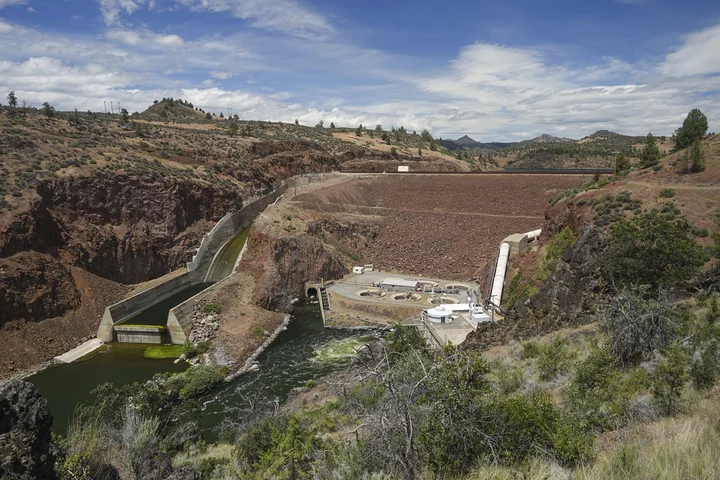
Before: Iron Gate.
After: No Iron Gate.
Copco No. 2, the smallest dam, was removed in the summer of 2023. In January of 2024 the Copco No. 1, JC Boyle, and Iron Gate reservoirs were drained, and deconstruction began in the spring. Massive amounts of concrete, earth, rocks and clay was removed from the river channel as part of the dam removal process. With these obstructions now cleared from the mainstem river, fish once again have access to more than 400 stream miles, including in tributary creeks and streams, of habitat in the upper Klamath Basin.
While the dam removal portion of the project is now complete, work will continue for several years restoring the 2,200 acres of formerly submerged lands. As the reservoirs drained in January, native seed mix was applied to the reservoir footprints. This initial round of seeding was intended to stabilize sediments and improve soil composition. This fall, restoration crews will turn their attention to amending soil conditions and will then perform another round of seeding and planting. Restoration crews will be onsite until vegetation success meets predetermined performance metrics. Restoration work is likely to continue for at least the next several years.
To learn more about the project, see klamathrenewal.org.
Before: JC Boyle.
After: No JC Boyle.

